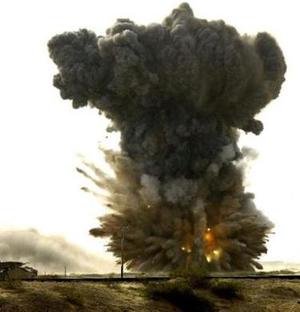In the trenchesDetecting fertilizer-based IEDs
Since 2008, IEDs have accounted for more than half of all fatalities incurred by NATO forces in Afghanistan; last year, 275 NATO soldiers died in IED attacks, and that number will likely be surpassed this year; already 228 NATO soldiers have died due to homemade bombs this year; the U.S. military continues to search for IED countermeasures

Fertilizer based IED detonation // Source: dianawest.net
Improvised explosive devices (IEDs) have been the preferred weapon of insurgents in Iraq and Afghanistan (and, earlier, by Hezbollah fighters against the Israeli forces which occupied southern Lebanon from 1982 to 2000), but IED materials often change from one conflict zone to another zone. In Afghanistan, the homemade bombs are built using fertilizer — as was the bomb Timothy McVeigh used in the Oklahoma City attack — a fact which has spurred a new Pentagon effort to spot them before they can go off, reports Danger Room’s Spencer Ackerman.
Matthew Harwood writes that this is where Task Force ODIN’s Project Ursus comes in:
[Lieutenant Colonel Kevin] Diermeier and [Major Jason] Periatt would only discuss Project Ursus in the vaguest of terms. But Ursus is aimed at finding what Diermeier and Periatt were allowed to call “generic homemade explosive observables.” To cut through the bureaucratese, Ursus is a surveillance program housed in a pod on the bottom of a piloted commercial King Air twin-engine turboprop plane (the MC-12 is one such modified aircraft) that hunts down the chemical signatures of fertilizers used in Afghanistan’s IEDs.
It’s an experimental program, barely out of the first month of a six-month trial run, so ODIN-Afghanistan’s leaders says it’s too soon to tell how successful it is. But so far, Ursus hasn’t accidentally confused any latrines or farms with bomb factories.
Project Ursus looks to address a sharp increase in the use of IEDs in Afghanistan. Harwood writes that in December 2008, approximately 300 IED events were recorded. This number has increased to 1,128 IED events by May 2010 (in this month’s cover story of Security Managament, Joe Straw explores more cutting edge research into explosives detection).
In late January Afghan President Hamid Karzai banned ammonium nitrate-based fertilizers to stem the number of roadside bombs targeting coalition fighters. This was not the first attempt to keep fertilizer out of the hands of insurgents. “The North Atlantic Treaty Organization, which has been seizing the fertilizer on its own since summer, has identified the primitive, fertilizer-packed roadside bomb as the weapon of choice of Taliban insurgents,” reported the Wall Street Journal. “Commanders say it could be as crucial to the Taliban as the surface-to-air missile was to the Afghan mujahedeen warriors in their fight in the 1980s against the Soviets.”
Since 2008, IEDs have accounted for more than half of all fatalities incurred by NATO forces, according to iCasualties.org. Last year, 275 NATO soldiers died in IED attacks. That number will likely be surpassed this year. Already 228 NATO soldiers have died due to homemade bombs this year.
